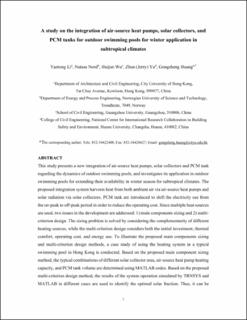| dc.contributor.author | Li, Yantong | |
| dc.contributor.author | Nord, Natasa | |
| dc.contributor.author | Wu, Huijun | |
| dc.contributor.author | Yu, Zhun | |
| dc.contributor.author | Huang, Gongsheng | |
| dc.date.accessioned | 2021-09-24T08:03:49Z | |
| dc.date.available | 2021-09-24T08:03:49Z | |
| dc.date.created | 2020-09-14T21:05:01Z | |
| dc.date.issued | 2020 | |
| dc.identifier.citation | Journal of Building Performance Simulation. 2020, 13 (6), 662-683. | en_US |
| dc.identifier.issn | 1940-1493 | |
| dc.identifier.uri | https://hdl.handle.net/11250/2781309 | |
| dc.description.abstract | This study presents a new integration of air-source heat pumps, solar collectors, and phase change material tanks regarding the dynamics of outdoor swimming pools, and investigates its application in outdoor swimming pools to extend their availability in the winter in subtropical climates. Since multiple heat sources are used, two issues in the development are addressed: (1) main component sizing and (2) multi-criterion design. The sizing problem is solved by considering the complementarity of different heating sources, while the multi-criterion design considers the initial investment, thermal comfort, operating costs, and energy use. Using TRNSYS and MATLAB combinations of different solar collector areas, air-source heat-pump heating capacities, and PCM tank volumes were investigated and analysed, among which optimal design was identified using a multi-criterion method. The proposed main components sizing and the multi-criterion design method could guide the design of a swimming pool heating system with multiple heat sources. | en_US |
| dc.language.iso | eng | en_US |
| dc.publisher | Informa UK Limted | en_US |
| dc.title | A study on the integration of air-source heat pumps, solar collectors, and PCM tanks for outdoor swimming pools for winter application in subtropical climates | en_US |
| dc.type | Peer reviewed | en_US |
| dc.type | Journal article | en_US |
| dc.description.version | acceptedVersion | en_US |
| dc.rights.holder | Copyright Informa Publishing Group | en_US |
| dc.source.pagenumber | 662-683 | en_US |
| dc.source.volume | 13 | en_US |
| dc.source.journal | Journal of Building Performance Simulation | en_US |
| dc.source.issue | 6 | en_US |
| dc.identifier.doi | 10.1080/19401493.2020.1813198 | |
| dc.identifier.cristin | 1829921 | |
| dc.relation.project | Norges forskningsråd: 262707 | en_US |
| cristin.ispublished | true | |
| cristin.fulltext | postprint | |
| cristin.qualitycode | 1 | |
